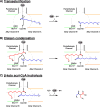The role of OleA His285 in orchestration of long-chain acyl-coenzyme A substrates
- PMID: 29430657
- PMCID: PMC5869120
- DOI: 10.1002/1873-3468.13004
The role of OleA His285 in orchestration of long-chain acyl-coenzyme A substrates
Abstract
Renewable production of hydrocarbons is being pursued as a petroleum-independent source of commodity chemicals and replacement for biofuels. The bacterial biosynthesis of long-chain olefins represents one such platform. The process is initiated by OleA catalyzing the condensation of two fatty acyl-coenzyme A substrates to form a β-keto acid. Here, the mechanistic role of the conserved His285 is investigated through mutagenesis, activity assays, and X-ray crystallography. Our data demonstrate that His285 is required for product formation, influences the thiolase nucleophile Cys143 and the acyl-enzyme intermediate before and after transesterification, and orchestrates substrate coordination as a defining component of an oxyanion hole. As a consequence, His285 plays a key role in enabling a mechanistic strategy in OleA that is distinct from other thiolases.
Keywords: OleA; X-ray crystallography; thiolase.
© 2018 Federation of European Biochemical Societies.
Figures







References
-
- Wackett LP. Engineering microbes to produce biofuels. Curr Opin Biotechnol. 2011;22:388–93. - PubMed
-
- Rude MA, Schirmer A. New microbial fuels: a biotech perspective. Curr Opin Microbiol. 2009;12:274–81. - PubMed
-
- Steen EJ, Kang Y, Bokinsky G, Hu Z, Schirmer A, McClure A, Del Cardayre SB, Keasling JD. Microbial production of fatty-acid-derived fuels and chemicals from plant biomass. Nature. 2010;463:559–62. - PubMed
-
- Friedman L RM. Process for producing low molecular weight hydrocarbons from renewable resources. WO/2008/113014 World Patent. 2008
Publication types
MeSH terms
Substances
Associated data
- Actions
- Actions
- Actions
- Actions
- Actions
- Actions
- Actions
- Actions
Grants and funding
LinkOut - more resources
Full Text Sources
Other Literature Sources
Molecular Biology Databases
Research Materials

